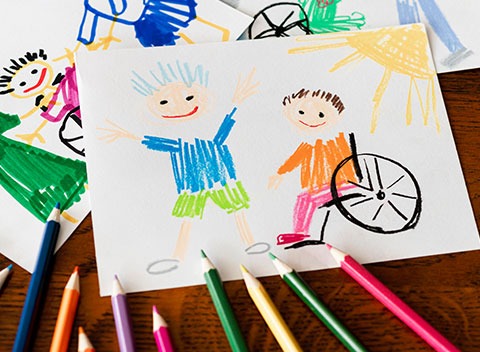Cerebral palsy and Speech Therapy Intervention
Cerebral palsy is a group of disorders that can affect movement, posture and balance.
The causes of cerebral palsy are related to brain damage that happened before birth or during birth. Some reasons why this happens are premature birth, being born too small, the mother having an infection during pregnancy, or different complications during birth.

What are the symptoms of cerebral palsy?
Symptoms and signs can vary greatly in every patient. Most common associated disturbances can be motor, sensory, cognitive, and behavioral dysfunctions, also some patients can have problems with communication and perception.
Movement and coordination problems associated with cerebral palsy can include stiff muscle or floppy muscle tone, lack of balance and coordination, tremor, difficulty walking, seizures.
Orofacial movement problems are associated such as excessive drooling or problems with swallowing, difficulty with sucking or eating, delays in speech development or difficulty speaking.
What is the impact of cerebral palsy on motor control for speech production?
Patients with cerebral palsy can have delays on early speech learning. The brain damage can impair strength, speed, accuracy, coordination and endurance of the muscle groups used to speak.
Also depending on the extent of the impairment, more of the speech processes such as respiration, phonation, resonance, articulation and intonation may be affected.
In addition to speech production, other aspects of communication that may be affected include such as understanding the use of words (vocabulary), comprehending and formulating linguistic messages using appropriate grammar, using language for different purposes and following conversational norms (pragmatics).
Who can help?
When areas of the brain that control speech production are affected, a child has to learn to control and coordinate the muscles to speak.

Speech and language therapists are the ones that can help improve communication skills in these patients. They are credentialed medical professionals with special communication training. They are interested in language development, human communication and related disorders.
Speech therapy supports development in these areas:
- producing sounds, words and syllables
- regulating voice volume
- listening and perception
- articulation and pronunciation
- vocabulary
- understanding and comprehending
- voice quality
- chewing and swallowing

What are the expectations of Speech and language therapy?
Before recommending speech exercises, a speech and language therapist conducts an assessment of each patient’s abilities and limitations. Drawing from various therapeutic techniques, a course of treatment is then constructed, with clear therapy goals in mind.
Once appropriate intervention is undertaken, periodic review and testing furnish vital feedback, enabling speech therapist to make adjustments to therapy.
As communication skills improve, cerebral palsy patients gain confidence and participate in a wider range of activities.
Effective therapy supports cognitive and emotional development; reinforcing social skills and helping children with cerebral palsy interact in diverse settings.

Benefits of Speech and Language therapy.
Improves confidence and self esteem
Increases the desire to interact socially
Improves learning and communicating at school
Helps patients with cerebral palsy to express thoughts and ideas
Patients can become more independent and have better problem-solving skills
Improves the overall quality of life

Conclusion
All speech therapists need to respond to the “complexity” challenge and provide children with cerebral palsy opportunities for intensive, task-focused speech therapy to achieve their potential and to learn to produce understandable, socially acceptable speech as part of their communication system in life.

